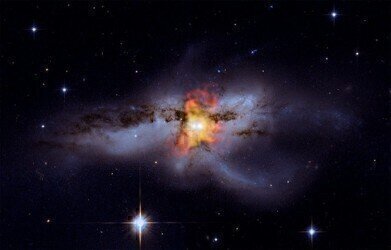News & Views
What Are Galactic Superwinds?
Mar 01 2016
Outer space is full of spectacular phenomena, from black holes and solar flares to shooting stars and meteors. Galaxy collisions are one particularly dramatic event, with a team at Japan’s Hiroshima University recently capturing the action with an ultra-advanced telescope.
Labelled case NGC 6240, the collision saw the merging of two active supermassive black holes, a kaleidoscope of newborn stars and a number of vast circumgalactic gas structures. Also known as an ultraluminous infrared galaxy (ULIRG). Using the Subaru Telescope, the team was able snap a high quality, detailed image of the widespread star-formation. This allowed them to see exactly what the gas structures looked like, and makes NGC 6240 one of the most well studied mergers in the universe.
Inside ULIRGs
So what exactly is NGC 6240? Scientists have revealed that the merger is located over 350 million light-years away, and ‘gives birth’ to around 25 to 80 times more stars than the Milky Way. In fact, the formation is so concentrated that it’s categorised as a class of galaxy called starbursts. Vast and sprawling, the outflow structure extends for around 300,000 light-years, peppered with a myriad of loops, filaments and blobs along the way.
Galactic winds are at the heart of the phenomenon, generated by stars clustered in the centre of NGC 6240. As young plasma spheres they emit high levels of ultraviolet light that force gas and dust forwards. Simultaneously, supernova explosions bring even more pressure that actively blows gas out of the galaxy, and into intergalactic space.
Scientists assert that the centre of the galaxy is home to two supermassive black holes, which boost energy output from the core, as well as strengthen the intensity of wind. As the winds are hot and laden with heavy elements, they have a weighty impact on the ‘ecosystem’ of the galaxy. If strong enough, winds such as the ones seen in NGC 6240 could rapidly disband a galaxy’s reservoir and suffocate the formation of new stars.
An ageing galaxy…
What’s next for NGC 6240? The team of university researchers predicts that it will continue to merge, and eventually evolve into an elliptical galaxy. Interestingly, this will mean that it hosts minimal star formations, and will submissively age until it comes into contact with another galaxy.
Modern space science is advancing in leaps and bounds, with institutions such as the University of Hiroshima pioneering new developments. But that doesn’t mean planet Earth has been left behind. At the Maastricht University, fundamental thrombosis and bleeding research is underway. For more information on the exciting new developments taking place in American labs, ‘Speeding up Research into Clotting and Bleeding’ is a must read article. It looks at the use of advanced software, and how model electron microscopes are being used to accelerate the analysis of a blood sample from three days to just three minutes.
Image via Flickr Creative Commons. Photo credits: NASA's Marshall Space Flight Center
Digital Edition
LMUK 49.7 Nov 2024
November 2024
News - Research & Events News - News & Views Articles - They’re burning the labs... Spotlight Features - Incubators, Freezers & Cooling Equipment - Pumps, Valves & Liquid Hand...
View all digital editions
Events
Nov 18 2024 Shanghai, China
Nov 20 2024 Karachi, Pakistan
Nov 27 2024 Istanbul, Turkey
Jan 22 2025 Tokyo, Japan
Jan 22 2025 Birmingham, UK




.jpg)














